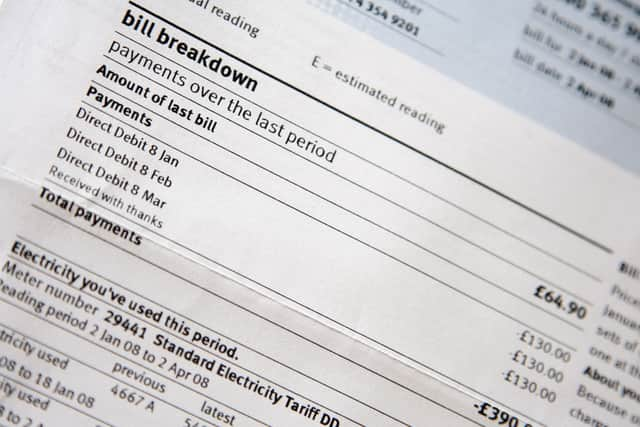What is the energy price cap? Will bills go up or down, fixed and variable tariffs - and recommended companies
and live on Freeview channel 276
Millions of families will see their energy bills rise again from the beginning of January, a new forecast has warned.
Industry regulator Ofgem is expected to announce next Thursday (23 November) that the energy price cap will be increased to 28.94p per unit of electricity and 7.42p per unit of gas from the start of next year.
It means that the typical household’s bill will rise from £1,834 per year to £1,931, according to experts at consultancy Cornwall Insight. It is Cornwall’s last forecast of what the price cap will be before Ofgem announces the level next week.
The forecasts show that the typical bill will then fall to £1,853 from the start of April, but not reduce to below today’s level until July next year.
But what exactly is the energy price cap, and can things like fixed rates or variable tariffs shield you somewhat from the effects of any increases? Here is everything you need to know.
What is the energy price cap?
The energy price cap is a limit set by the government on the maximum amount energy suppliers can charge customers on their standard variable or default tariffs. It was introduced to protect consumers from paying excessively high prices for their gas and electricity.
The cap is reviewed biannually by Ofgem, the energy regulator in the UK, and it's based on various factors like wholesale energy costs, network costs and policy costs. It aims to reflect the true cost of supplying energy to households while ensuring a fair price for consumers.
For those paying energy bills, the price cap acts as a safeguard against steep price hikes. It provides some assurance that the energy rates won't exceed a certain limit, which can offer financial relief for households, especially during times of volatile energy markets or rising wholesale prices.


However, it's important to note that being on a tariff subject to the price cap doesn’t necessarily mean you're getting the best deal, as there might be cheaper fixed-rate or variable-rate tariffs available outside the capped range.
While the price cap offers short-term protection, it's still crucial for consumers to regularly review their energy tariffs and consider switching to more competitive deals to potentially save money in the long term.
From 1 October 31 December 2023, the energy price cap stands at £1,834 annually for a standard household using gas and electricity and paying via Direct Debit.
Are fixed rates better than a variable tariff?
Choosing between fixed energy tariffs and variable rates depends on your preferences and the market conditions at the time, and each option has its own set of advantages and disadvantages when it comes to energy bill prices.
Fixed Energy Tariffs
With a fixed tariff, the rate you pay for your energy remains constant for the duration of the fixed term (usually 1-3 years). This shields you from price increases due to market fluctuations, providing budget certainty.
Knowing the exact amount you'll pay each month can help with budgeting, making it easier to manage household expenses, and if energy prices rise during the fixed period, you'll likely save money compared to those on variable tariffs.
However, if energy prices drop during your fixed term, you won't benefit from the lower rates unless you switch to a different tariff, potentially missing out on savings.Some fixed tariffs also have exit fees if you want to switch before the fixed term ends, limiting your flexibility.
Variable Energy Rates
Variable rates can go up or down based on market conditions. If energy prices fall, you'll benefit from lower bills without the need to switch tariffs. Typically, variable tariffs also don’t have exit fees, so you're free to switch to a different tariff or supplier without penalties.
On the other hand, your bills can change unpredictably if energy prices rise, making budgeting more challenging; variable tariffs might end up more expensive than fixed tariffs during periods of significant price increases in the energy market.
If energy prices are relatively low or stable, a variable rate might offer more immediate savings. However, if prices are expected to rise, a fixed tariff can protect against future increases.
Some prefer the stability of fixed tariffs for peace of mind, while others are comfortable with potential fluctuations in variable rates. Regularly reviewing and comparing tariffs can help ensure you're on the most suitable plan for your needs.
Are any companies in particular recommended by the switching sites?
Specific energy companies are often recommended by switching sites based on their competitive pricing, customer service, and additional benefits they offer.
However, the landscape of energy providers and their rankings for value and service can change frequently due to market dynamics, new offers and customer feedback.
Therefore, it is advisable to consult these sites or comparison services at the time of considering a switch to get the most up-to-date and personalised advice tailored to your specific needs and location.
Switching sites regularly update their recommendations based on real-time pricing, customer reviews, and any new tariffs or deals offered by energy suppliers.
Factors such as your consumption patterns, the area you live in, and your preferences (such as renewable energy options or specific customer service requirements) can influence which provider might offer you the best value for your energy needs.
Always compare tariffs and consider reading customer reviews to ensure you're making an informed decision that aligns with your priorities.
Comment Guidelines
National World encourages reader discussion on our stories. User feedback, insights and back-and-forth exchanges add a rich layer of context to reporting. Please review our Community Guidelines before commenting.
